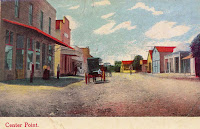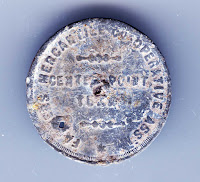 |
| The home of Charles Ganahl, and the post office of Zanzenburg, Texas. Image taken in the 1930s. Source: Library of Congress. Click on any image to enlarge. |
The town has gone by a different name since 1872, when its postmaster, Dr. G. W. Harwell, renamed the community Center Point, and moved the post office south of the Guadalupe River.
Until then, the post office had been north of the river, and the first post office was in the home of Dr. Charles de Ganahl, who gave the community its original name. Zanzenburg was the name of his ancestral home in the Austrian Tyrol.
 |
| Downtown Center Point, around 1900 |
In the late 1850s, Dr. Charles de Ganahl moved to Kerr County to start a plantation, ranch, and horse operation, and was listed as the person who owned the most slaves in the 1860 census. Of the 49 slaves enumerated there, Ganahl owned 24.
He was very supportive of the Confederate cause, and that support would eventually cause him many troubles.
Ganahl represented Kerr County in the Texas secession convention, and voted for Texas to secede from the Union. He joined the confederate army as a surgeon.
After the war, Ganahl chose to not take the oath of allegiance to the United States, and lived in Mexico for several years. He finally returned to Kerr County in 1879, his health failing. He died in 1882, and is buried in Center Point.
 |
| Center Point Roller Mills |
 |
| Center Point Fairgrounds |
In February, 1913, the community voted to incorporate for municipal government purposes, and appointed a mayor, city clerk and other officers. Only a few months later, in October, 1913, the voters decided to dissolve the new government.
Another round of incorporation occurred recently, in the 1990s, and a mayor and city council were elected, though that experiment in local government was also terminated by the voters about two years later.
I have several interesting Center Point items in my collection of historical Kerr County photos and artifacts.
 |
| Trade Coin, Farmers Mercantile Co-operative Assn, Center Point |
Another is a photograph of the Woolls Building in Center Point, which was built in the early 1870s by G. W. Woolls and used for a general store. After a fire in 1900, the building was purchased in 1902 by the Farmers Mercantile Cooperative Association (which issued the trade coin I found).
My friend Deborah Gaudier found an advertisement for the Cooperative: "it is not a money making, but a money saving institution...net profits are returned to patrons as a dividend on their purchases."
 |
| Woolls Building, Center Point. Note cow and calf on balcony. |
But the most intriguing thing about the photograph is on the second story balcony. Four men and two boys are shown there along with a cow and calf. A broken tree branch has fallen between the group and the stairway down.
I wish I knew the story about the cattle being upstairs on the balcony in downtown Center Point at the turn of the last century!
Until next week, all the best.
Joe Herring Jr. is a Kerrville native who would like to have more items from Center Point in his collection. If you have an old photograph of Center Point you'd like to share with him, he'd be happy to scan it and give it back to you. This column originally appeared in the Kerrville Daily Times August 11, 2018.


The cow appears to be a small Brahman with the hump. Can't tell about the calf. Maybe it was an early publicity shot. Those cattle would have to be awfully gentle to be able to lead them up stairs. Down stairs might be even more difficult.
ReplyDeleteLove it, Joe! Awesome as always!
ReplyDelete